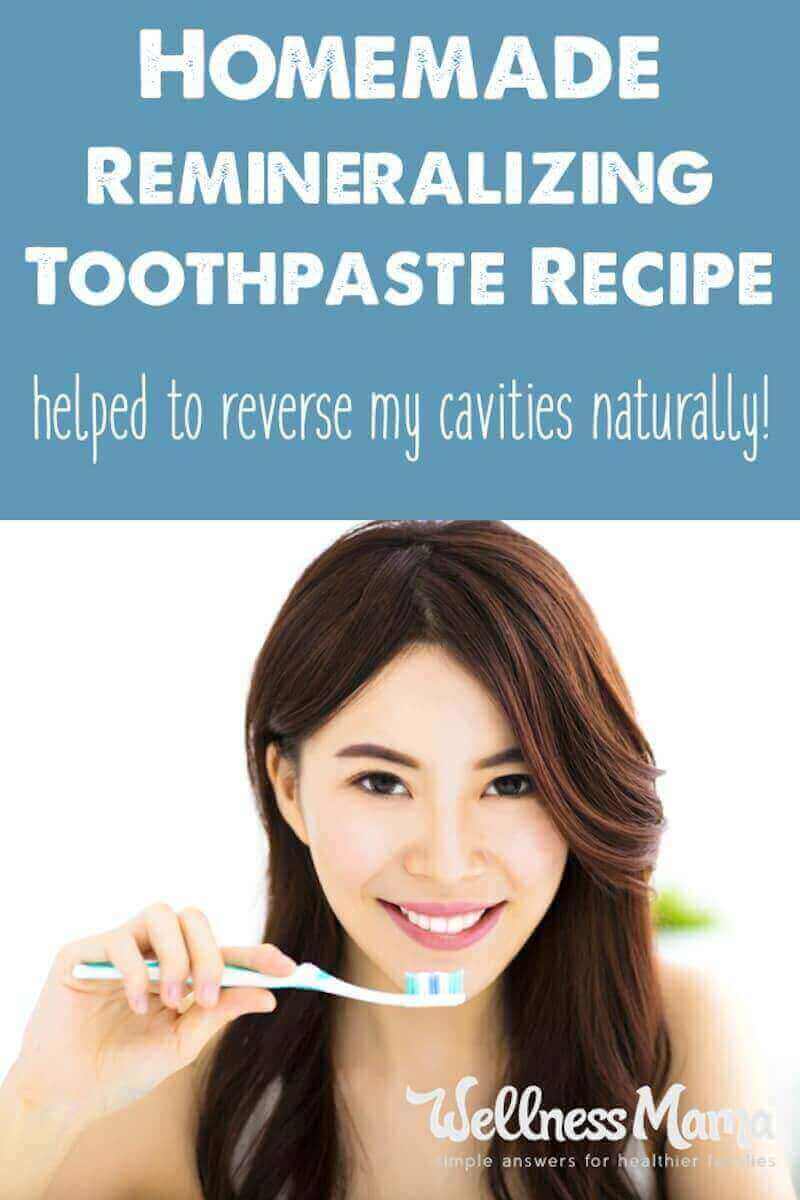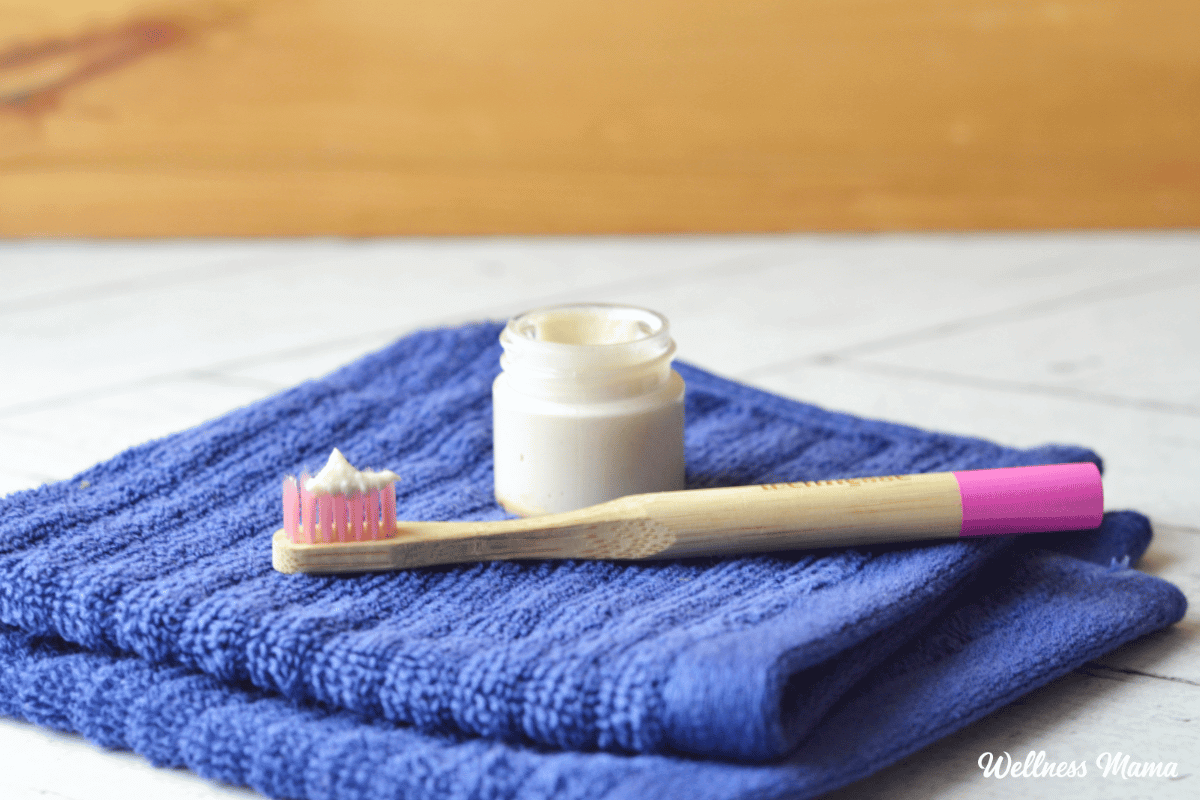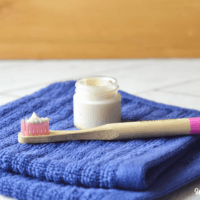I’ve mentioned before how I stopped tooth decay and helped remineralize teeth. For healthy tooth enamel, it’s important to focus on good nutrition and have a great oral care routine. If you’re dealing with sensitive teeth, this homemade remineralizing toothpaste helps reverse and prevent demineralization!
When I was actively working on my cavities I used a two-part approach. First, I addressed my mineral levels through what I ate and drank. I also used a natural remineralizing toothpaste for enamel repair. I’ve since noticed a huge improvement in tooth sensitivity and no new caries!
A Remineralizing Toothpaste
There’s a lot of information about tooth remineralization, a process many dental health professionals previously thought impossible. This article details the science behind tooth remineralization and which foods to eat (and avoid!) for success. You’ll also learn why most toothpaste ingredients, even those with natural ingredients, aren’t the best.
Conventional formulations like Sensodyne reduce tooth sensitivity with fluoride and potassium nitrate. While I’m not a fan of fluoride, there are other issues with some brands that claim they’re remineralizing.
Silica, especially in whitening toothpastes can sometimes be too harsh. The SLS added for foaming can cause mouth and gum sensitivity. Nano-hydroxyapatite toothpaste has recently gained popularity as an alternative to fluoridated toothpaste, but it presents problems too. You can read more about that here.
Over the years I’ve uncovered a lot about having a healthy mouth. What I’ve found mirrors my own experience with natural, fluoride-free toothpaste and a remineralizing diet.
Don’t want to make it? Try the remineralizing toothpastes at Wellnesse!
Natural Toothpaste
I’ve definitely noticed major changes in my teeth after using this toothpaste. It gets rid of buildup to help with teeth whitening and makes them feel really clean. Others who’ve tried it have told me the same thing.
The most surprising change in my teeth was that they’re no longer sensitive to cold! For as long as I can remember, biting into anything cold (or even thinking of it!) made me shudder and hurt my front teeth. After changing my dental care I noticed I could eat cold foods without my teeth hurting. I’ve never been able to do that before!
This toothpaste recipe is kid-approved, and since it has no fluoride, it’s safe for babies, toddlers, and those with thyroid problems.
Ingredients and Substitutions
I’ve made several toothpaste recipes over the years with varying ingredients. All of them have ingredients that help strengthen enamel (and improve sensitivity) to some degree. Here are the ingredients and what they do for a healthier mouth
- Calcium – I used to use calcium carbonate in this recipe to help rebuild enamel. While it’s still a good option, calcium phosphate is even better. You can even use finely powdered, dried eggshells for calcium if preferred. A coffee grinder works well for this.
- Baking Soda – A gentle abrasive that helps clean teeth and reduce plaque buildup.
- Diatomaceous Earth – Mineral rich and full of silica for strong teeth and bones. It’s also slightly abrasive to clean teeth.
- Xylitol – Adds some sweetness to balance out the mineral taste. Xylitol also has a lot of oral health benefits and helps prevent cavities. If you prefer not to add it though you could replace it with a little stevia to taste.
- Coconut oil – This helps pull everything together and turns it from a powder into a toothpaste. Coconut oil also helps reduce plaque, prevent gingivitis, and balances mouth bacteria. If your house is colder you can replace half of the solid coconut oil with fractionated coconut oil or MCT oil.
- Essential oils – These add antimicrobial properties for oral health and freshen breath. Some good options include cassia cinnamon, clove, peppermint, spearmint, myrrh, or sweet orange. Start with a little and increase as desired in the recipe to avoid any irritation.
- Mouth oil – Instead of adding essential oils, try a premade healthy mouth oil. I like this one from Wellnesse that features ingredients like manuka, and organic cinnamon and mint essential oil.
A note on abrasiveness: There’s been some concern diatomaceous earth or baking soda can be too harsh on teeth. While we don’t want to wear away enamel, DE and baking soda can be gentle options. Baking soda rings in at a 2.5 on the MOHS hardness scale compared to silica at 6 or 7. DE is even gentler than that with a score of 1 to 1.5.
Remineralizing Toothpaste Recipe
Equipment
- 4-ounce glass jar
Materials
- 2 and ½ TBSP calcium phosphate
- ½ TBSP diatomaceous earth
- 1 TBSP baking soda
- 2 TBSP coconut oil
- 1 and ½ TBSP xylitol powder (optional)
- 10-15 drops essential oils (peppermint, spearmint, etc. optional)
- 15 drops Balanced Mouth Blend (optional, instead of essential oils)
Instructions
- In a bowl, mix together the calcium, diatomaceous earth, baking soda, and xylitol.
- Add the coconut oil a little at a time until you reach the desired consistency.
- Add essential oils or Balanced Mouth Blend if using.
- Store in small glass jar.
- Use a clean popsicle stick or spoon to scoop some out and onto a toothbrush. Do not dip the toothbrush into the jar as this introduces bacteria and cause it to spoil faster.
- Storage and Shelf Life: Store in a cool place away from direct sunlight for up to 2 years. Replace it if it starts to smell off or look discolored.
Notes
- The amount of coconut oil can vary you need to form a paste consistency can vary from 1 and 1/2 TBSP to 2 and 1/2 TBSP coconut oil. You can also replace half of the solid coconut oil with fractionated or MCT oil if your house is cold. This keeps it from getting too hard!
- If you don’t have a 1/2 Tablespoon measuring spoon, it’s the same as 1 and 1/2 teaspoons.
More Natural Oral Care Options
Oral hygiene involves more than just toothpaste! Here are some more healthy mouth products to make or buy. I’ve included my brand Wellnesse for those who are too busy or just want a premade option.
- Silk Floss from Wellnesse
- Floss picks (great for kids)
- Oral probiotic
- Homemade mouthwash (this balanced mouth blend also doubles as a mouthwash)
- Coconut oil pulling chews
The Internal Side of Remineralization
Remineralization doesn’t only happen in the mouth. Simply using a toothpaste with a higher concentration of minerals likely won’t be enough to help teeth. Remineralization is a whole-body process. In order for it to happen we need enough of certain nutrients, especially minerals and fat-soluble vitamins.
When I was actively working on remineralizing my teeth, I focused on a specific nutrient-rich diet. I also avoided foods with sugar and phytic acid and added other lifestyle factors to boost nutrient levels. You can read my daily oral health routine in this post.
Getting enough minerals and fat-soluble vitamins are important not only because they support the body as a whole, but they create more mineral-rich saliva. Our bodies need healthy saliva to deliver the necessary nutrients to teeth.
I saw the best results with this two-pronged approach: eating for oral health and using this remineralizing toothpaste!
Ever made your own remineralizing toothpaste? Let us know how it worked!






Leave a Reply